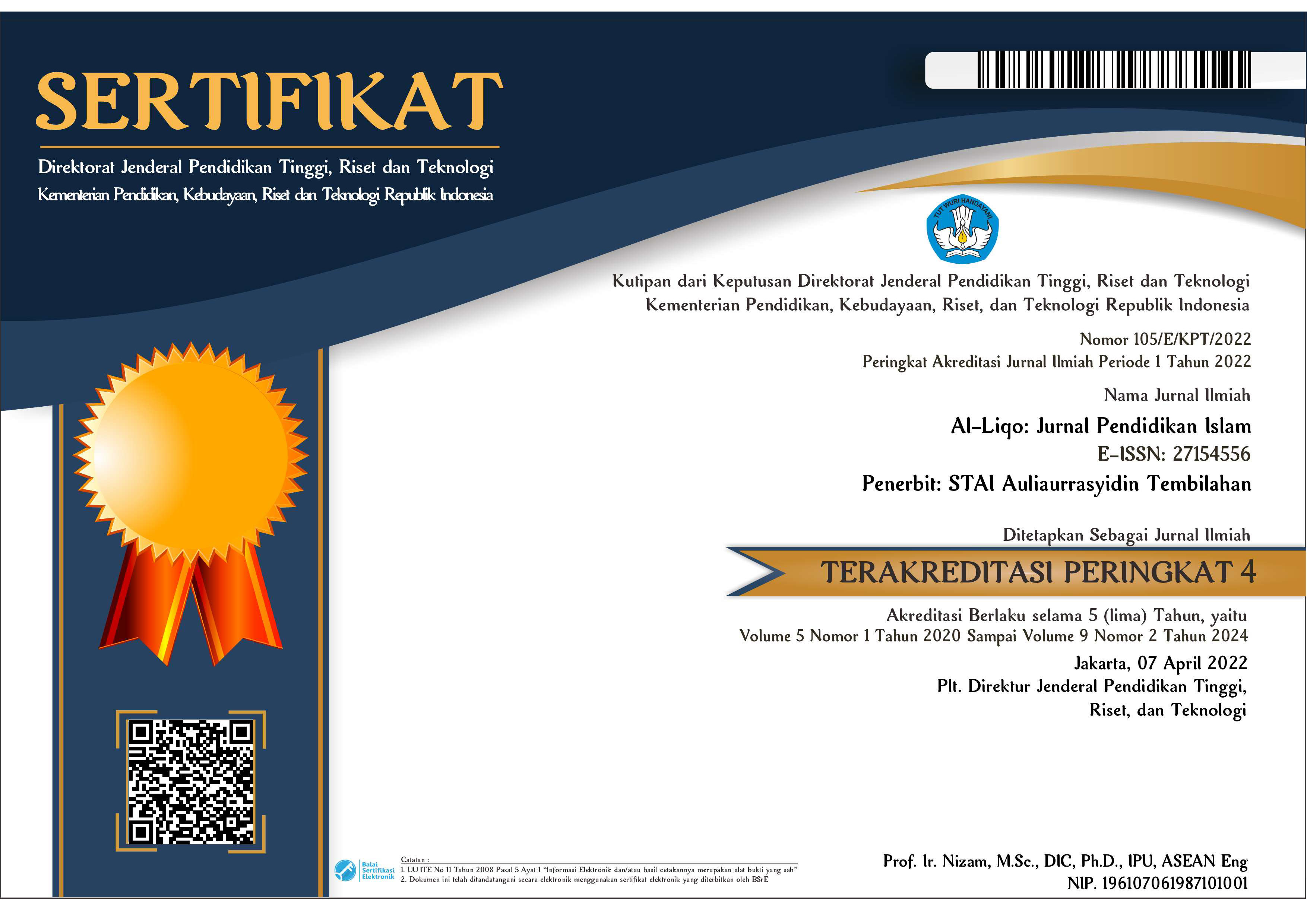Konsep Pendidikan Karakter Dalam Al-Qur'an Dan Hadits
DOI:
https://doi.org/10.46963/alliqo.v6i2.443Keywords:
The Concept of Character Education, The Qur'an and HadithAbstract
The formulation of the problem in this writing is how the concept of character education according to the Qur'an and Hadith? While the goal is to know the concept of character education that exists in the Qur'an and Hadith. This type of research is library research, the data sources used are primary and secondary data sources with deductive and inductive thinking. How to collect data with documentation study and analyze with the method of Tafsir maudhu'i and sarah Hadith. The results found in the verses of the Qur'an about the concept of character education are found in surah as-Shaff verses 2-3, surah Lukman verses 12-14 and surah at-Taubah verse 119. While the Hadith related to the concept of character education is Hadith about hypocrisy, Hadith devotion to both parents and Hadith about honesty, the three Hadiths are narrated by Muttafaqun 'alaih. The concept of character education according to the verses of the Qur'an above we must be istiqomah and unity between words and deeds, be grateful to Allah SWT, believe in Allah SWT by not associating with Him, devotion to parents, honest, avoid hypocritical traits to himself and others, while the concept of character education according to the Hadith we must not lie, betray, do not keep promises, but we must respect, love and be honest to anyone whose goal is to make a perfect human being.
Downloads
References
Al-‘Asqalani, Ibnu Hajar. (2010). Fathul Bari Syarah Shahih Bukhari Kitab Wahyu Dan Iman. Jakarta: Pustaka Iman Asy-Syafi’i.
Al-Hasyimi, Sayyid Ahmad. Syarah Mukhaarul Ahaadiits, (Bandung: PT. Sinar Baru Algensindo. 2014)
Anwar, Rosihon. . 2000. Ulumul Qur’an. (Bandung CV Pustaka Setia)
Asy, Maftuh Ahnan. (2003). Kumpulan Hadits Terpilih Shahih Bukhari. Surabaya: Terbit Terang.
Asy–Syifa. (2011). Al-Qur’an Dan Terjemahnya. Semarang: PT Raja Publishing.
Hatta, Ahmad. (2009). Tafsir Al-Qur’an Perkata Dilengkapi Dengan Asbabun Nuzul & Terjemah. Jakarta: PT Maghrirah Pustaka.
Ilyas, Yunahar. Kuliah Akhlak, (Yogyakarta: Lembaga Pengkaji Dan Pengalaman Islam/LIPI,2014)
Kementerian Agama RI. (2011). Al-Qur’an Dan Tafsirnya Edisi Yang Disempurnakan. Jakarta: Widya Cahaya.
Lickona, Thomas. Educating For Character: How Our School Can Teach Respect and Responsibility. (New York: Bantam Books,1992)
Mahalli, Ahmad Mudjab. (2004). Hadis-Hadis Muttafaq ‘Alaih Bagian Ibadat. Jakarta: Prenada Media.
Marzuki. (2015). Pendidikan Karakter Islam. Jakarta: Amzah.
Mudzhar, M.Atho. Dkk. (2010). Al-Qur’an Dan Tafsirnya Edisi Yang Disempurnaka. Jakarta: Lentera Abadi.
Mujib. (2007). Abdul. Kepribadian Dalam Psikologi Islam. Jakarta: Pt Raja Grafindo Persada.
Najieh, Ahmad. (2011). Akhlaq Rasulullah SAW. Surabaya: Riyan Jay.
Samani, Muchlas dan Hariyanto. (2013). Konsep dan Model Pendidikan Karakter. Bandung : PT Remaja Rosdakarya.
Shihab, M.Quraisy. (2002). Tafsir Al-Misbah Pesan, Kesan Dan Keserasian Al-Qur’an. Jakarta: Lentera Hati.
Tafsir, Ahmad. (2005). Ilmu Pendidikan Dalam Perspektif Islam. Bandung: PT Remaja Rosdakarya.
Downloads
Published
Issue
Section
License
Authors who publish with this journal agree to the following terms:
1. Copyright on any article is retained by the author(s).
2. The author grants the journal, right of first publication with the work simultaneously licensed under a Creative Commons Attribution shareAlike 4.0 International License that allows others to share the work with an acknowledgment of the work’s authorship and initial publication in this journal.
3. Authors are able to enter into separate, additional contractual arrangements for the non-exclusive distribution of the journal’s published version of the work (e.g., post it to an institutional repository or publish it in a book), with an acknowledgment of its initial publication in this journal.
4. Authors are permitted and encouraged to post their work online (e.g., in institutional repositories or on their website) prior to and during the submission process, as it can lead to productive exchanges, as well as earlier and greater citation of published work.
5. The article and any associated published material is distributed under the Creative Commons Attribution-ShareAlike 4.0 International License







2.png)



